Edith Cowan | |
|---|---|
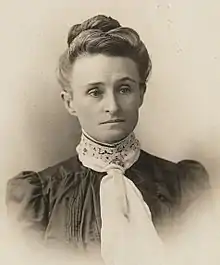 Cowan in c. 1900 | |
| Member of the Legislative Assembly of Western Australia for West Perth | |
| In office 12 March 1921 – 22 March 1924 | |
| Preceded by | Thomas Draper |
| Succeeded by | Thomas Davy |
| Personal details | |
| Born | Edith Dircksey Brown 2 August 1861 Glengarry station, near Geraldton, Western Australia |
| Died | 9 June 1932 (aged 70) Subiaco, Western Australia |
| Resting place | Karrakatta Cemetery |
| Political party | Nationalist |
| Spouse |
James Cowan (m. 1879) |
| Relatives | Ayla Lewkowski (great-grandniece)[1] |
Edith Dircksey Cowan OBE (née Brown; 2 August 1861 – 9 June 1932) was an Australian social reformer who worked for the rights and welfare of women and children. She is best known as the first Australian woman to serve as a member of parliament. Cowan has been featured on the reverse of Australia's fifty-dollar note since 1995.
Cowan was born at Glengarry station near Geraldton, Western Australia. She was the granddaughter of two of the colony's early settlers, Thomas Brown and John Wittenoom. Cowan's mother died when she was seven, and she was subsequently sent to boarding school in Perth. At the age of 15, her father, Kenneth Brown, was hung for the murder of her stepmother, making her an orphan. She subsequently lived with her grandmother in Guildford, Western Australia until her marriage at the age of 18. She and her husband would have five children together, splitting their time between homes in West Perth and Cottesloe.
In 1894, Cowan was one of the founders of the Karrakatta Club, the first women's social club in Australia. She became prominent in the women's suffrage movement, which saw women in Western Australia granted the right to vote in 1899. Cowan was also a leading advocate for public education and the rights of children (particularly those born to single mothers). She was one of the first women to serve on a local board of education, and in 1906 helped to found the Children's Protection Society, whose lobbying resulted in the creation of the Children's Court the following year. Cowan was a co-founder of the Women's Service Guild in 1909, and in 1911 helped establish a state branch of the National Council of Women.
Cowan was a key figure in the creation of the King Edward Memorial Hospital for Women, and became a member of its advisory board when it opened in 1916. She was made a justice of the Children's Court in 1915[2][3] and a justice of the peace in 1920. In 1921, Cowan was elected to the Legislative Assembly of Western Australia as a member of the Nationalist Party, becoming Australia's first female parliamentarian. She was defeated after just a single term, but maintained a high profile during her tenure and managed to secure the passage of several of her private member's bills.
Early life
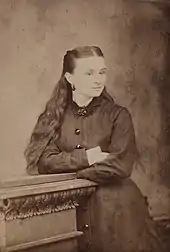
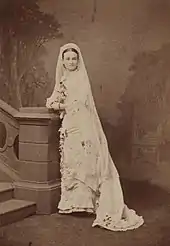
Cowan was born on 2 August 1861 at Glengarry, a sheep station near Geraldton, Western Australia.[lower-alpha 1] She was the second child of Kenneth Brown, pastoralist and son of early York settlers Thomas and Eliza Brown, and his first wife Mary Eliza Dircksey Wittenoom, a teacher and the daughter of the colonial chaplain, J. B. Wittenoom. Cowan's mother died in childbirth in 1868 when Cowan was only seven. She went to a Perth boarding school run by the Misses Cowan,[5] sisters of her future husband. Her adolescence was shattered in 1876 by the ordeal of her father's trials and hanging for the murder, that year, of his second wife. He murdered his second wife by shooting her when they were packing. Cowan was a solitary person, committed nevertheless to social reforms which enhanced women's dignity and responsibility and which secured proper care for mothers and children.
After her father's death, she left her boarding school and moved to Guildford to live with her grandmother. There, she attended tuition of Canon Sweeting, a former headmaster of Bishop Hale's School who had taught a number of prominent men including John Forrest and Septimus Burt. According to her biographer, Sweeting's tuition left Cowan with "a life-long conviction of the value of education, and an interest in books and reading".
Community work
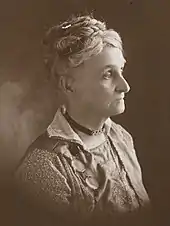
Cowan became involved with social issues and injustices in the legal system, especially with respect to women and children. In 1894, she helped found the Karrakatta Club, a group in which women "educated themselves for the kind of life they believed they ought to be able to take". In time, she became the club's president, life member, and trustee.[6] The Karrakatta Club became involved in the campaign for women's suffrage, successfully gaining the vote for women in 1899.
After the turn of the century, she turned her eye to welfare issues. She was particularly concerned with women's health and the welfare of disadvantaged groups, such as disadvantaged children and prostitutes. She became extraordinarily active in women's organisations and welfare organisations, serving on numerous committees. The building of Perth's King Edward Memorial Hospital for Women in 1916 was largely a result of her efforts. She helped form the Women's Service Guilds in 1909 and was a co-founder of the Western Australia's National Council of Women, serving as president from 1913 to 1921 and vice-president until her death. Cowan was also a Western Australian delegate to the national assembly for 19 years.[6]
In 1916, she became a Freemason, admitted to the Australian federation of Droit Humain.[7]
She believed that children should not be tried as adults and, accordingly, founded the Children's Protection Society. The society had a major role in the subsequent introduction of children's courts. In 1915, she was appointed to the bench of the new court[2][3] and continued on in this position for eighteen years. In 1920, she became one of the first female Justices of the Peace. Her great great nephew David Malcolm followed in her footsteps, by becoming Chief Justice of the Supreme Court of Western Australia in 1988.
During World War I, she collected food and clothing for soldiers at the front and coordinated efforts to care for returned soldiers. She became chairperson of the Red Cross Appeal Committee and was rewarded when, in 1920, she was appointed an Officer of the Order of the British Empire (OBE).[8]
In her final years, she was an Australian delegate to the 1925 International Conference of Women held in the United States. She helped to found the Royal Western Australian Historical Society in 1926 and assisted in the planning of Western Australia's 1929 Centenary celebrations. Though she remained involved in social issues, illness forced her to withdraw somewhat from public life in later years.
Community positions held
Beside being a Member of Parliament, Cowan held positions on many boards in Western Australia, in 1929 during the centenary The West Australian published a list of these;[6]
- Perth Hospital Board
- King Edward Maternity Hospital Advisory Board
- Chairman of the Perth Hospital Red Cross Auxiliary
- President of the Military Nurses Home committee
- President of Pageantry and sights committee – WA Historical Society
- Vice President of WA League of Nations Union
- Red Cross division committee
- Children's Protection Society
- Town Planning Association
- Housewives Association
- Infant Health Association
- WA Historical Society
- Nationalist Party Executive
- Governor of St Mary's Church School
- General and Provisional Synods of the Church of England
- Bush Nursing Association
- Centenary Committee
- Women's Immigration Auxiliary
- Girl Guides Council
- Karrakatta Club
- Western Australia National Council of Women
Politics
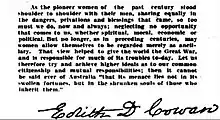
In 1921, Western Australia passed legislation allowing women to stand for parliament. At the age of 59, she stood as the Nationalist candidate for the Legislative Assembly seat of West Perth because she felt that domestic and social issues were not being given enough attention. She won a surprise victory, defeating the Attorney-General, Thomas Draper, who had introduced the legislation that enabled her to stand. Cowan was the first woman to be elected to an Australian parliament. She campaigned for women's rights in parliament, pushing through legislation which allowed women to be involved in the legal profession. She succeeded in placing mothers in an equal position with fathers when their children died without having made a will and was one of the first to promote sex education in schools. However, she lost her seat at the 1924 election and failed to regain it in 1927.
Personal life
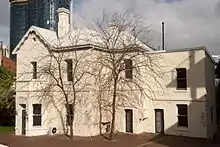
At the age of 18, on 12 November 1879, Edith married James Cowan, then Registrar of the Supreme Court. They lived at Scotstoun, 71 Malcolm Street, West Perth[10] for most of their lives, but are also well known for having one of the first houses in Avonmore Terrace, Cottesloe, where they lived from 1896 to 1912.[11] Cowan was married in St George's Cathedral, Perth. She was one of the first women elected to the Anglican Synod in 1916.
Death and burial
Following an extended period of ill-health Cowan died of pancreatic cancer at the Avro Hospital, Subiaco on 9 June 1932, at the age of 70. After a short service at St. Mary's Church, West Perth, a large public funeral was held at Karrakatta Cemetery where she was buried.[12][13]
Legacy
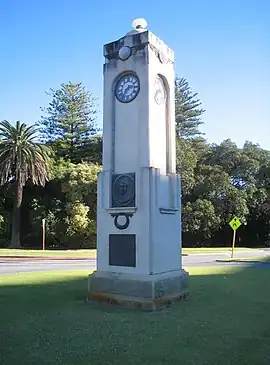

Two years after her death, the Edith Cowan Memorial Clock was unveiled at the entrance to Perth's Kings Park. Believed to be the first civic monument to an Australian woman, it was built in the face of persistent opposition which has been characterised as "representative of a gender bias operating at the time".[14]
Her portrait featured on an Australian postage stamp in 1975,[15] as part of a six-part "Australian Women" series. Australia Post honoured Edith again in 2021, for the centenary of her election, as Australia’s first woman parliamentarian. During the WAY 1979 sesquicentennial celebrations, a plaque was laid in St Georges Terrace in her honour. It is on the corner of Milligan Street and is for 1921.
In 1984, the federal Division of Cowan was created and named after her, and in January 1991 the Western Australian College of Advanced Education was renamed Edith Cowan University (ECU).[16]
Her portrait appears on the Australian fifty dollar note, a polymer banknote that was first issued in October 1995. In 2019 the release of the latest $50 note caused a sensation when it was discovered that the word 'responsibility' in Edith Cowan's speech was spelt incorrectly, missing the last 'i'. In 1996, a plaque honouring her was placed in St George's Cathedral, Perth. There are references to her in the Centenary of Western Australian Women's Suffrage Memorial in Kings Park, and in a tapestry that was hung in King Edward Memorial Hospital in 2000 to honour women involved in the hospital.
In 1991, Edith Cowan University purchased the house in which Edith Cowan, her husband and family had resided at 71 Malcolm Street.[17] They resided in the house from 1919 for approximately 20 years.[17] The house was reconstructed on the university's Joondalup campus with the assistance of the West Coast College of TAFE. The reconstructed house opened in 1997[17] as Building 20 on that campus, and currently houses the Peter Cowan Writer's Centre.[18]
Edith Cowan was added to the Victorian Honour Roll of Women[19] in 2001. Her life was the subject of the stage play With Fire in Her Heart: the Edith Cowan Story by Western Australian author and playwright Trevor Todd, in 2020.
Notes
- ↑ Glengarry station is now located in Moonyoonooka, a rural locality on the eastern margin of Geraldton.[4]
References
- ↑ "Ancestry ties to further education and life-long learning".
- 1 2 "News and notes". The West Australian. Perth, WA. 10 June 1915. p. 6. Retrieved 1 November 2020.
- 1 2 "Mainly About People". Daily News. Perth, WA. 31 July 1915. p. 5. Retrieved 1 November 2020.
- ↑ "Municipal Inventory of Heritage Places Place Record: Glengarry" (PDF). City of Greater Geraldton. 13 December 2018. Retrieved 31 May 2021.
- ↑ "Review". The Herald. Fremantle. 20 February 1869. p. 2. Retrieved 29 May 2021.
- 1 2 3 "CENTENARY PERSONALITIES". The West Australian. Vol. XLV, no. 8, 437. Western Australia. 5 July 1929. p. 6. Retrieved 23 April 2019 – via National Library of Australia.
- ↑ "Female Freemasons". International Order of Freemasonry for Men & Women - Australian Federation. Retrieved 8 November 2021.
- ↑ It's an Honour: OBE. Retrieved 16 December 2015
- ↑ Acott, Ken (25 September 2016). "Old home saved from demolition". The West Australian. Retrieved 2 October 2016.
- ↑ "InHerit - State Heritage Office".
- ↑ "Cowan, Dircksey Constance (1880-)". Trove. National Library of Australia. Retrieved 7 May 2020.
- ↑ "The Late Mrs Cowan - Impressive Funeral". The West Australian. Perth, WA. 13 June 1932. p. 12. Retrieved 25 May 2020.
- ↑ "Mrs Cowan's death". The Daily News. Perth, WA. 9 June 1932. p. 1. Retrieved 25 May 2020.
- ↑ Heritage Council of Western Australia, 2000
- ↑ Australian Women stamps series: Edith Cowan http://www.australianstamp.com/images/large/0011310.jpg
- ↑ History of Edith Cowan University and its Predecessor institutions http://www.ecu.edu.au/GPPS/rams/history.html Archived 15 March 2012 at the Wayback Machine
- 1 2 3 Edith Cowan House: the reconstruction http://trove.nla.gov.au/work/36356521
- ↑ Peter Cowan Writer's Centre "Peter Cowan Writers' Centre". Archived from the original on 26 February 2011. Retrieved 16 August 2010.
- ↑ "Victorian Honour Roll of Women 2001" (PDF).
Other sources
- Black, David; Bolton, Geoffrey (2001). Biographical Register of Members of the Parliament of Western Australia, Volume One, 1870–1930 (Revised ed.). Parliament House: Parliament of Western Australia. ISBN 0730738140.
- Black, David and Phillips, Harry (2000). Making a Difference: Women in the Western Australian Parliament 1921–1999. Parliament House, Perth, Western Australia: Parliament of Western Australia. ISBN 0-7307-4464-7.
{{cite book}}: CS1 maint: location missing publisher (link) CS1 maint: multiple names: authors list (link) - Cowan, Peter (1978). A unique position: a biography of Edith Dircksey Cowan 1861–1932. Nedlands, Western Australia: University of Western Australia Press. ISBN 0-85564-135-5.
- Serle, Percival (1949). "Cowan, Edith". Dictionary of Australian Biography. Sydney: Angus & Robertson.
- "Edith Dircksey Cowan Memorial" (PDF). Register of Heritage Places – Assessment Documentation. Heritage Council of Western Australia. 20 December 2000. Archived from the original (PDF) on 20 August 2006. Retrieved 24 May 2006.
External links
- Cowan, Edith Dircksey at The Encyclopedia of Women and Leadership in Twentieth-Century Australia
- Edith Dircksey Cowan in Biographical Register of Members of the Parliament of Western Australia